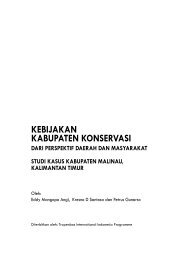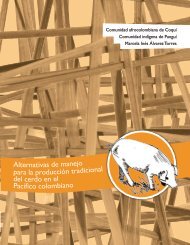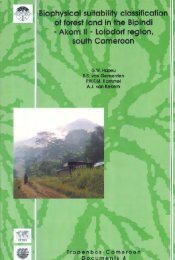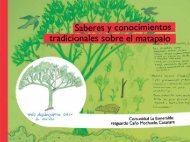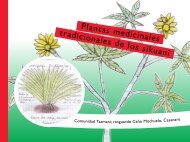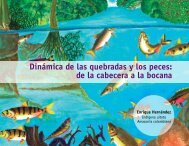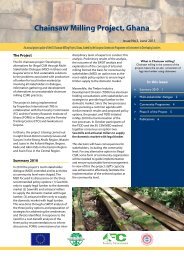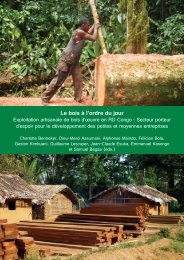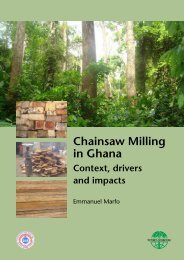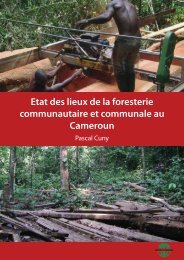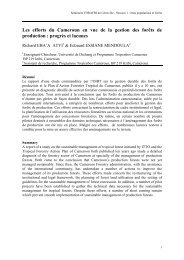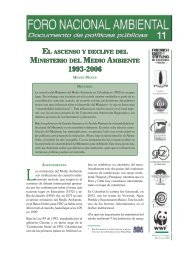Download the publication - Tropenbos International
Download the publication - Tropenbos International
Download the publication - Tropenbos International
Create successful ePaper yourself
Turn your PDF publications into a flip-book with our unique Google optimized e-Paper software.
Diversity patterns in <strong>the</strong> flora of <strong>the</strong> Campo-Ma’an rain forest, Cameroon: do tree species tell it all?<br />
The species richness was also significantly different between growth forms (GLM:<br />
F3, 33.2 = 221.889, P < 0.001 for layer and F10, 30 = 2.973, P < 0.01 for vegetation type<br />
included as a random factor), with similar relative difference. Overall, <strong>the</strong>re was a<br />
decrease in diversity and <strong>the</strong> total number of species recorded/plots with decreasing<br />
sampling resolution (Figures 3.5 & 3.6). About 30% of <strong>the</strong> total number of species<br />
recorded was lost when <strong>the</strong> sampling design only took into account all vascular<br />
plants with DBH ≥ 5 cm and more than 50% were lost when only vascular plants<br />
with DBH ≥ 10 cm are collected. Moreover, <strong>the</strong>re was a very strong significant<br />
positive correlation between <strong>the</strong> number of stems/ha and <strong>the</strong> total number of species<br />
recorded (R 2 = 0.956, P < 0.0001), and a considerable drop in diversity when <strong>the</strong><br />
sampling was limited to all vascular plants with DBH ≥ 10 cm. In terms of sampling<br />
effort, less than 30% of <strong>the</strong> total number of stems/ha were recorded when <strong>the</strong><br />
sampling design only took into consideration all vascular plants with DBH ≥ 5 cm.<br />
Fur<strong>the</strong>rmore, only 15% of <strong>the</strong> total number of stems/ha were recorded for all<br />
vascular plants with DBH ≥ 10 cm.<br />
Species richness within families<br />
Overall, shrubs/small trees show <strong>the</strong> highest number of families (75) followed by<br />
medium trees (61), herbs and hemi-epiphytes (58), large trees (54) and woody<br />
climbers (37). Rubiaceae was by far <strong>the</strong> most species rich family (204 species)<br />
followed by Euphorbiaceae (88), Leguminoseae-Caesalpinioideae (85), Annonaceae<br />
(63), Sterculiaceae (50), Apocynaceae (47) and Sapindaceae (40). Leguminoseae<br />
(especially <strong>the</strong> sub-family Caesalpinioideae) was <strong>the</strong> dominant family for <strong>the</strong> large<br />
trees species (DBH ≥ 30 cm) in terms of relative density and frequency in <strong>the</strong><br />
Campo-Ma’an area (Table 3.7). Dominant large tree species included Brachystegia<br />
cynometroides, Calpocalyx heitzii, Desbordesia glaucescens, Erythrophleum<br />
ivorensis, Lophira alata, Lovoa trichilioides, Piptadeniastrum africanum,<br />
Pterocarpus soyauxii, Pycnanthus angolensis, Sacoglottis gabonensis and<br />
Terminalia superba. Common shrubs and small tree species included Jollydora<br />
duparquetiana, Lasian<strong>the</strong>ra africana, Massularia acuminata, Podococcus barteri<br />
and many species of <strong>the</strong> genera Campylospermum, Cola, Crotonogyne, Diospyros,<br />
Drypetes, Microdesmis, Psychotria, Rinorea and Scaphopetalum. Common large<br />
woody climber species were from <strong>the</strong> genera Agelaea, Dichapetalum, Combretum,<br />
Laccosperma, Landolfia, Millettia, Salacia and Strychnos. The most important herb<br />
species were Costus englerianus, Haumania danckelmaniana, Leptaspis zeylanica,<br />
Marantochloa monophylla, Microcalamus barbinodis, Puella ciliata, P.<br />
schumanniana, and many species of <strong>the</strong> genera Asystasia, Begonia, Cercestis,<br />
Culcasia, Dorstenia, Geophila, Hymenocoleus, Mapania, and Palisota.<br />
51



